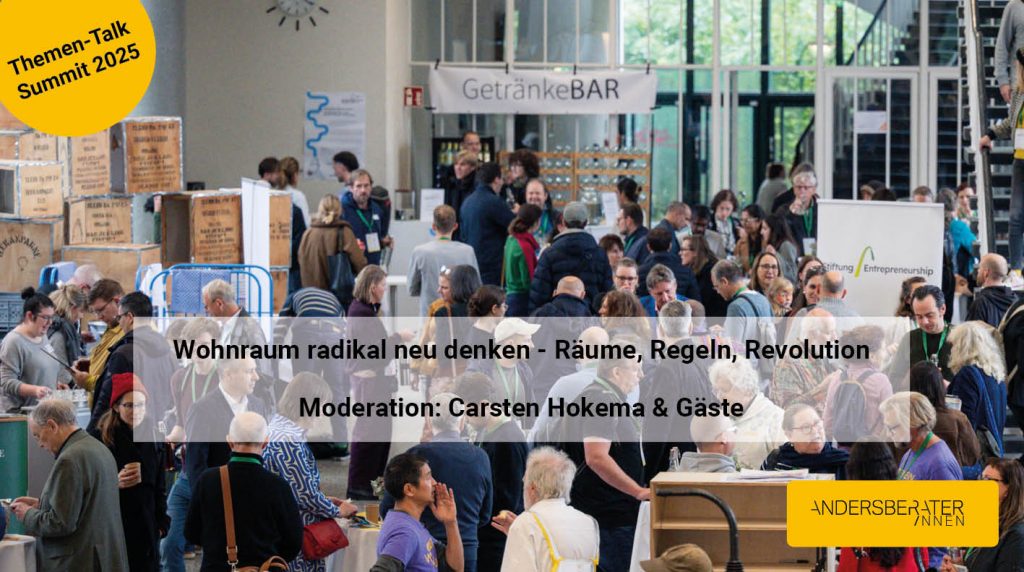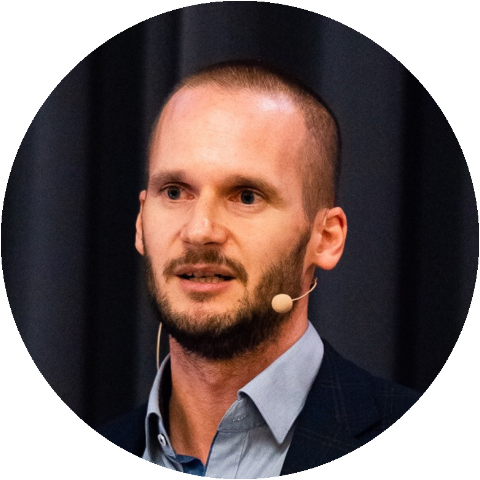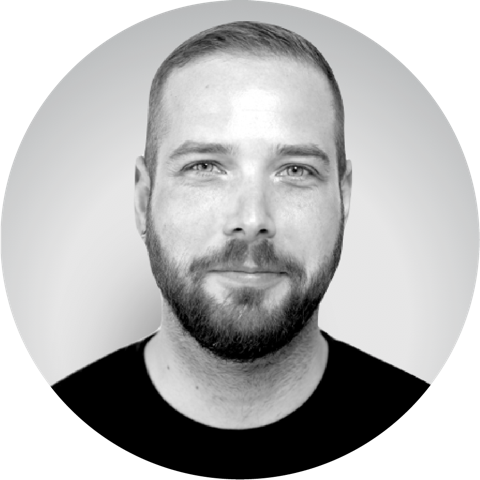Living space radical new thinking – spaces, rules, revolution
A review of an lively discussion at the Entrepreneurship Summit 2025 …
Housing: an urgent issue that affects everyone.
Germany is in the midst of a housing crisis. Affordable, sustainable and liveable housing is lacking in all corners – not only in the metropolises, but also in medium-sized towns and in the countryside. High construction costs, rigid regulations, lack of space and rising interest rates are exacerbating the situation. But at the same time new initiatives are emerging: communal housing projects, serial timber construction methods, digital planning processes and bold political ideas. (here you can find the video recording of the a54> entire event)
This was precisely the starting point for our panel discussion “Radically rethinking living space – rooms, rules, revolution,” which took place on October 12, 2025, at the Entrepreneurship Summit in Berlin. As an architect, moderator, and member of Andersberater Berlin, I had the opportunity to discuss with experts from the fields of architecture, urban planning, politics, start-ups, and the housing industry how we can shape the living spaces of tomorrow – affordable, sustainable, and people-centered.
Dreams, rules, revolution – more than just buzzwords
The title was deliberately programmatically chosen. “Spaces” stand for what our coexistence shapes – our neighbourhoods, quality of life and participation, but also for the question of the the for humane housing minimum floor space of a flat. “Rules” symbolise the structures that often prevent progress and stability, even though they are meant to ensure stability and security (building type E for “simple” lets here greetings). And “Revolution“ refers to the courage that we need to rethink these structures in a new way to.
So it wasn’t about minor reforms, but rather the question: How can we create a construction and housing system that is sustainable – socially, ecologically, and economically?
Between idealism and reality
The discussion was characterized by a productive tension: idealistic visions clashed with practical obstacles. It quickly became clear that Germany does not have a problem with awareness, but rather with implementation. The tools for sustainable construction have long been available—from modular wood systems and digital planning models to participatory development processes. However, many projects fail due to approvals, funding guidelines, or fear of the unknown.
As tempting as radical thinking may sometimes be, “in the end, it still has to result in a decent house!” – Jörg Gustav Haertwig.
This sentence reminds us of what it is all about at its core: humane, functional and beautiful living spaces to create. Technology and innovation are means to an end, not an end in themselves.
Digitalisation as a tool, not a miracle cure
Also about digitalisation was discussed as one of many issues. a9> many adjustment screws discussed. Building Information Modelling (BIM), AI-supported designs and automated construction processes can bring enormous efficiency gains bring – if they are used correctly.
Digitalisation can revolutionise planning and construction processes – but only if it is linked to a new understanding of values : less resource consumption, more transparency, more humanity.
Construction transition as a joint task
One central theme of the event was the construction revolution – in other words, the transformation towards a socially and ecological sustainable building culture. It can only succeed if we understand building as a communal task.
This means thinking about resources in cycles to reuse reusing materials and planning neighbourhoods in such a way that they remain transformable. that they remain adaptable remain adaptable. It also means actively involving people, instead of only regarding them as users at the end of the day.
A communal housing project in Brandenburg (the Kodorf in Wiesenburg) organises itself independently – with regional timber construction, solidarity-based financing and open neighbourhood structure. Such projects prove that alternatives have long existed, if one lets them exist.
Politics and the courage to change
Without bold political decisions however much remains theory.
Whether land policy, building regulations or subsidy logic – currently block many well-intentioned regulations the urgently needed transformation.
It was at the Entrepreneurship Summit that it became clear how important it is for founders to that founders, architects and politicians form alliances forge. The construction revolution needs innovative spirit – and that arises where people from different backgrounds come together. where people from different backgrounds come together and jointly break new ground and pave new paths.
Dialogue instead of expert circles
What made the event special was its open format. The audience discussion was not an add-on, but rather the centrepiece of the event.
This polyphony demonstrated what constitutes the Andersberater approach: dialogue across disciplines and beyond.
Not complaining, but shaping. Don’t just analyse, but act.
For us as Andersberater Berlin, this round was another further step on our path, architecture, entrepreneurship and social responsibility with each other to combine.
Visions of the future: How we might live tomorrow
At the end, the question remained: How might housing look in 20 years’ time, if we act courageously today?
The visions were diverse:
- Buildings as adaptable systems that adapt to life stages and needs.
- Neighbourhoods that share energy, water and space share.
- Hybrid forms of living and working that reduce mobility and promote community and.
- Digital twins of cities that facilitate participation.
These visions of the future show that the solutions lie not in some distant utopia – they are already emerging today in real-world laboratories, start-ups and committed architectural firms. What is lacking are structures that enable this change, but the right mindset among legislators and administrators.
Radical thinking, real action
This year’s summit demonstrated how far we still have to go. how far we still are from effective solutions, gave us courage too.
He showed that the energy for change is available in – in the architecture, in the start-up scene, in the society. But change needs space: legal, intellectual and physical.
If we can manage it can become a new beginning out of the housing crisis a new start a fresh start a new beginning.
A movement that makes building once again what it a19> makes it what it once was: a cultural, social and human act.
Or, to conclude with the words of one participant:
“Revolution” does not mean chaos. Revolution means taking responsibility for what we build and what we do. – for what we build and what we leave behind.” The Zukunftswerstatt Planen und Bauen supports architects in also their own future in a self-reliant manner to shape.
Carsten Hokema



